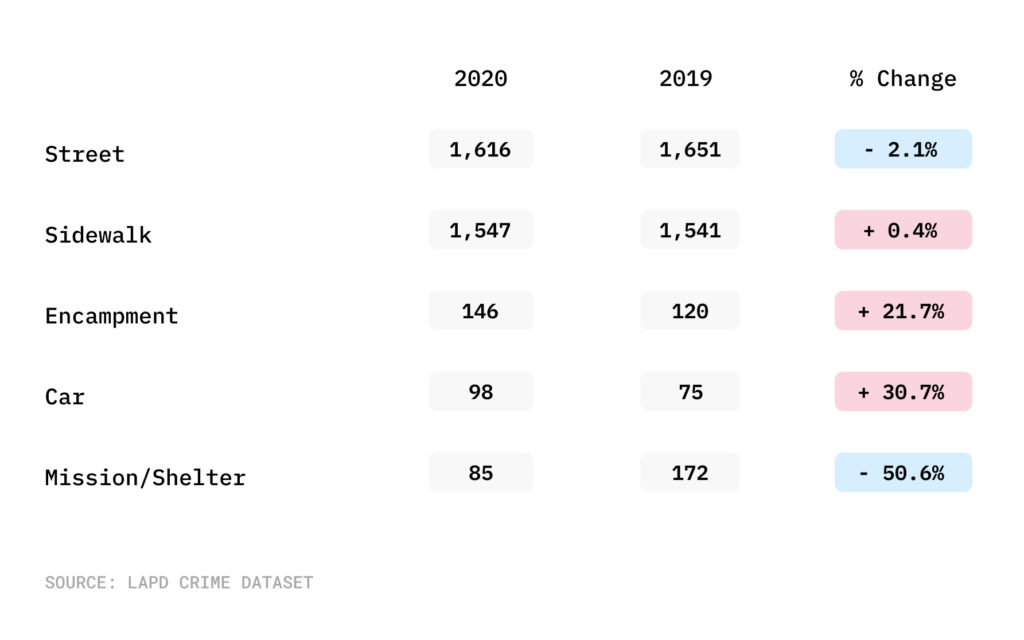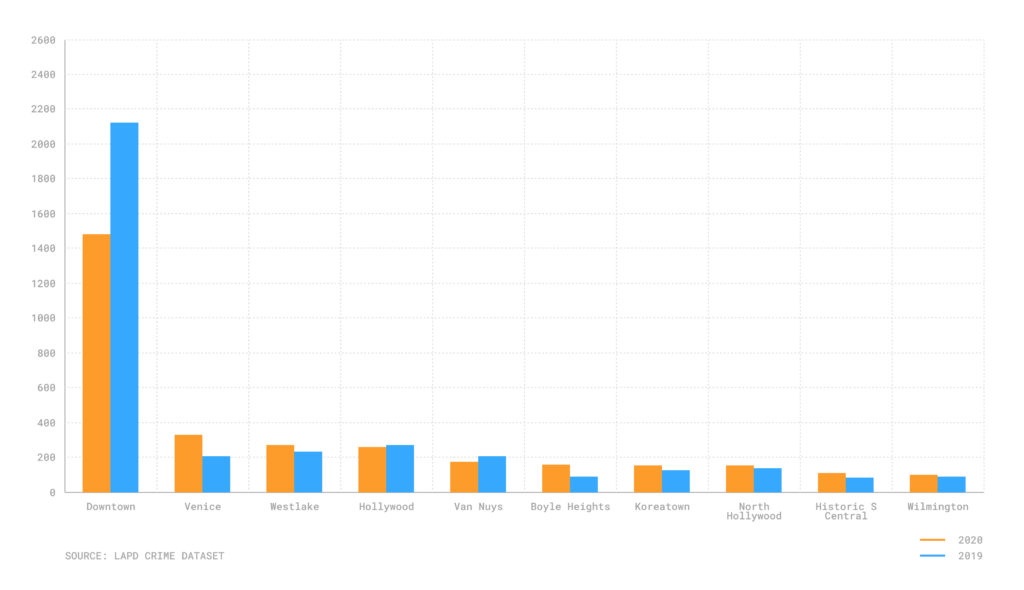Crime statistics barely budge for Angelenos experiencing homelessness

Overall crime in Los Angeles fell nearly 11% last year. However, some of the city’s most vulnerable residents did not see as much relief: According to Los Angeles Police Department data, incidents in which the victim was a person experiencing homelessness (PEH) declined only 3%.
There were 5,601 crimes last year where the victim was experiencing homelessness, down from 5,776 in 2019. LAPD data showed that 2,191 victims were female, a nearly 13% drop from 2019. The 3,369 men who were a victim represents a 3% increase from the previous year.
One significant shift involved crimes reported at missions or shelters; the 85 incidents last year is a nearly 51% decrease from the 172 in 2019.
Donald Graham, the homeless coordinator for the LAPD, said the coronavirus pandemic led to a concerted effort to depopulate missions. Many lost 70% of their floor space.
“Fewer people, less concentration, less crime,” said Graham. “Another thing that’s different is that in all 24 shelters we established throughout the city, we had police officers there 24-7.”
Although crime in shelters decreased, the number of victims in homeless encampments rose by nearly 22%, and the number of PEH targeted in cars soared by 31%.
Locations where people experiencing homelessness were victims of crime, 2020 vs. 2019

The greatest number of crimes where the victim was experiencing homelessness occurred in Downtown, though the 1,482 victims was a 30% decline from 2019. Although the second most-active area, Venice, saw a fraction of Downtown’s number, with 329 criminal reports, that represented a 60.5% jump from 2019.
Boyle Heights reported 157 incidents where the victim was a PEH. That is a 76% increase over the 89 in 2019.
Graham attributed the increase in Boyle Heights to a growing number of homeless gang members who were let out of prison or allowed to finish their sentence without incarceration, but were not given the resources to get housing for themselves or did not reconnect with family.
Historic South-Central also saw a sharp uptick in victims who were experiencing homelessness. The 108 incidents marked a 33% increase from the 81 in 2019.
Neighborhoods where people experiencing homelessness were victims of crime, 2020 vs. 2019

“I can see why the numbers are going up,” said Azusena Favela, a member of the Historic South-Central neighborhood council. “When people end up on the street they are already a victim of a system that failed them.”
Favela saw a connection between COVID, an increase in unemployment leading to frustration from an already vulnerable community, and policy decisions about where campers can park, as many were forced to move from well-lit spaces to darker, less-trafficked areas. At her group’s next meeting she plans to discuss ways to help people who are experiencing homelessness.
“The cycle of victimizing them continues,” said Favela. “We have created an environment for this to happen. We have tried to move them from being visible to invisible in our communities.”
The 12,029 incidents in which a suspect who committed a crime was also experiencing homelessness represents a .9% increase from the 11,920 in 2019, according to the LAPD.
Common threads
In addition to the 30% decline in victims who were experiencing homelessness, Downtown also saw a 30.5% drop in suspects who were PEH.
Graham, the LAPD’s homeless coordinator, said the declines occurred because Downtown was the epicenter for services rendered to the homeless population last year, particularly with coronavirus testing and outreach.
“Police officers and other people were checking on people and administering tests, so that will clamp down on a lot of crime,” he said.
One area where crime involving PEH rose was Koreatown. The neighborhood saw a 23% increase in victims experiencing homelessness and a 34% rise among suspects.
Adriane Hoff, president of the Wilshire Center Koreatown Neighborhood Council, said she felt the increase by walking around the community.
“It’s staggering,” she said. “It’s really tragic to read that a person experiencing homelessness is also being the victim of a crime. It’s like adding insult to injury for the most vulnerable in our city.”
In the effort to address the situation, Hoff’s neighborhood council is seeking a new chair for its homelessness committee. Engagement is atop the priority list.
“The vision I have for it is I really want them to focus on collaborating with community organizations that are already doing that work,” she said, referring to outreach measures. “We don’t need to reinvent the wheel. We can assist those organizations by giving them grants, co-hosting events, etc. I’m a big believer in collaboration and helping one another out.”
How we did it: We examined publicly available LAPD data on reported crimes in the city of Los Angeles. For neighborhood boundaries, we rely on the borders defined by the Los Angeles Times. Learn more about our data here.
LAPD data only reflects crimes that are reported to the department, not how many crimes actually occurred. In making our calculations, we rely on the data the LAPD makes publicly available.
The LAPD periodically updates past crime reports with new information, leading the department to recategorize past reports. Additionally, revised reports do not always automatically become part of the public database.
Want to know how your neighborhood fares? Or simply just interested in our data? Email us at askus@xtown.la.






